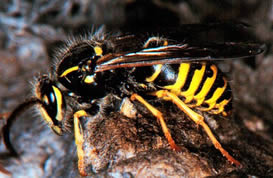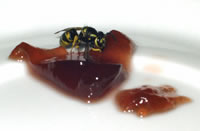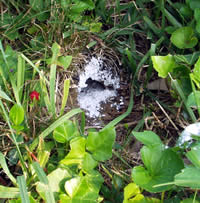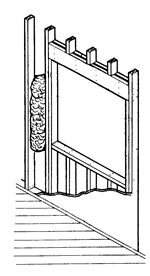 |
| The surest way to control yellowjackets is to find and eliminate their nest |
Photo © Jim Kalisch, Entomology Dept., |
Tracking Yellowjackets Back to Their Nest
The surest way to control yellowjackets is to find and eliminate their nest. Of course, this can be easier said than done. The nest can be well hidden inside a dense bush, or buried in the ground with only a small, hard-to-see entrance hole, or located deep inside a wall void of a building. A nest can be hundreds of feet from where the yellowjackets are bothering people. And there can be more than one yellowjacket nest causing problems in a backyard or public area, often many more.
Sometimes a nest is found when someone disturbs it and gets stung. More often, though, there is a problem with yellowjackets foraging for food in an area--a backyard patio or an outdoor restaurant--and you're asked to get rid of them. Not an easy task.
Follow the Yellow Brick Road....
Once you know how to track foraging yellowjackets, you can often follow them to the nest. They all tend to leave and enter the nest on the same flight path going in the same direction. Yellowjackets are easiest to see against the sun.
Stand still and look across an area of yard that is in full, bright sun. Yellowjackets tend to zip quickly by on a straight path rather than flying in curves or other patterns. If you see an insect fly quickly by, continue looking in the same place. If you see more zip past in the same spot, you’ve probably found yellowjackets going to and from the nest. Follow them until you can see where they’re entering and exiting.
 |
| Fruit jellies and other sweet foods are strong yellowjacket lures in late season |
| Photo © Pinto & Associates, Inc. |
If you can’t find yellowjackets flying, you can still track them by first luring them to a food bait. Place the food bait near where you suspect the nest is located. Some of the best protein baits are tuna-flavored canned cat food, liverwurst, chicken skin, cold cuts, or ground meat. In fall, sugar baits such as fruit jelly, fruit juice, ice cream, and the liqueur grenadine may be more effective. It shouldn’t take long for yellowjackets to discover the bait. As the yellowjackets carry off bits of the food, try to follow their path back to the nest.
Mark all the nests you find. Do not quit when you find a yellowjacket nest; there may be many more. Keep monitoring and keep looking.
Treating a Yellowjacket Nest
It is always best to treat a yellowjacket nest at night (45 minutes after sunset or later) when most of the workers are back in the nest. Of course, that is not always possible. Just realize that if you treat during the day many of the workers, perhaps as many as 60 or 80 percent, may be out of the nest during your treatment. However you decide treat a nest, be sure to leave some insecticide dust at the entrance to kill yellowjackets returning later.
Aerial Nest
Saturate the nest opening and the nest itself with a "quick knockdown" or "quick freeze" wasp and hornet spray. Some are designed to spray 10-15 feet enabling you to treat a nest without a ladder. You can also use a "bee pole" for nests far above ground.
 |
| Yellowjacket ground nest treated with an insecticide dust |
| Photo © Pinto & Associates, Inc. |
Ground Nest
You can treat ground nests with either a labeled insecticide dust or a wasp and hornet spray or both (our preferred method).
It is sometimes difficult to get a "quick knockdown" wasp and hornet spray all the way down to the nest. On occasion, workers and brood in a treated nest will survive and the nest will reactivate in a couple of days. If you use a wasp and hornet spray, follow-up with some insecticide dust (labeled for wasps and bees) into the entrance hole.
Wall Void Nest
 |
| Yellowjacket nest inside wall void |
| USFS illustration modified by Sandra Kraft |
Sometimes yellowjackets, especially the German yellowjacket, decide to build a nest inside a building rather than outside. Common nest sites include wall voids, drop ceilings, attics, and voids in concrete block. Nests are usually the size of a basketball, but can grow ten times larger. Nests in void spaces are irregularly shaped to fit the void. There are at least three possible scenarios that you could find yourself facing with an indoor nest:
1. You found the entrance hole.
Yellowjackets take advantage of openings on the outside of buildings. They can enter a void through a hole in mortar, space around a window frame, or an opening around a conduit, vent, or exhaust fan. The bad news is that finding the entrance hole doesn't mean you've found the nest. If you're lucky, it may be only a few inches away, but it can be as much as 30 feet from the entrance.
Sometimes you can locate the nest by placing your ear (or a listening device) against a wall and listening for activity.
If you can't find the nest site for a more precise treatment, first use a "quick-freeze" aerosol product to eliminate stirred-up yellowjackets near the entrance. Make sure that the insecticide will not blow out of the void into the room on the opposite wall through electrical outlets, vents, or holes. If the nest is far away, an aerosol may not reach it.
A residual dust will drift further into the void and can be carried back to the nest on the bodies of returning workers. Also, since some of the brood may still emerge days later, a residual in the nest will eliminate these as well. Make sure the dust is labeled for an indoor site. Don't close the entrance hole after treatment. Leave it open so any returning yellowjacket workers will have to pass through the insecticide.
2. You know exactly where the nest is located in the void.
Drill a small hole into the wall or ceiling at the nest site and inject an aerosol or dust directly into the nest. Then seal this drill hole. If you've also found the outside nest entrance, treat that as described in #1 above and leave the entrance hole open.
3. Yellowjackets have emerged inside.
In this worst-case scenario, the yellowjackets have chewed through plasterboard or found some other opening from the void into a room. This happens naturally if the nest grows too big for the void space. It can also happen if a failed insecticide treatment flushes them out of the nest site, particularly if the nest entrance is blocked.
Close off that room if possible. Use a space spray labeled for indoor use to knock down the yellowjackets. Next step is to find out how they're getting into the room. Sometimes, they'll find an existing opening where the floor and wall meet behind molding, or will emerge from a light fixture.
If they've chewed through plasterboard, you should see a soft, wet area around the opening. Before you inject insecticide into this space, you should strengthen the area by putting overlapping strips of masking tape across it to reach solid plasterboard on each side. Then cut a small hole in the tape and inject an aerosol or dust that is labeled for this use. Cover the hole with a final piece of tape and wait a few days before having the plasterboard repaired.
Closeout procedures.
Regardless of which treatment you've done, it's best to wait at least a couple of days before checking for any activity and closing out the job. Decide whether or not the nest should be removed from the void. The decision to remove the nest assumes that you know its precise location. In some cases where plasterboard has to be repaired anyway, the nest is exposed and easily removed.
In most cases, yellowjacket nests in voids don't need to be removed. Consider the following:
- If the nest is in an unoccupied area like an attic, it would be less likely to cause problems later than if it is in a living space.
- If the nest is inside cinder block or behind expensive wood paneling, it could be expensive to remove.
- If the nest has a large number of dead larvae, they could rot and cause an odor problem or attract insects. [A nest treated late in summer or fall will be mostly empty of larvae.]
If the nest is not going to be removed, as a final step inject a long-lasting repellent insecticide into the nest. This will kill any yellowjackets that may still emerge and it will prevent dermestid beetles and other secondary pests from infesting the old nest. Also seal the entrance hole on the outside to prevent a new yellowjacket queen from using the same site in the future.
